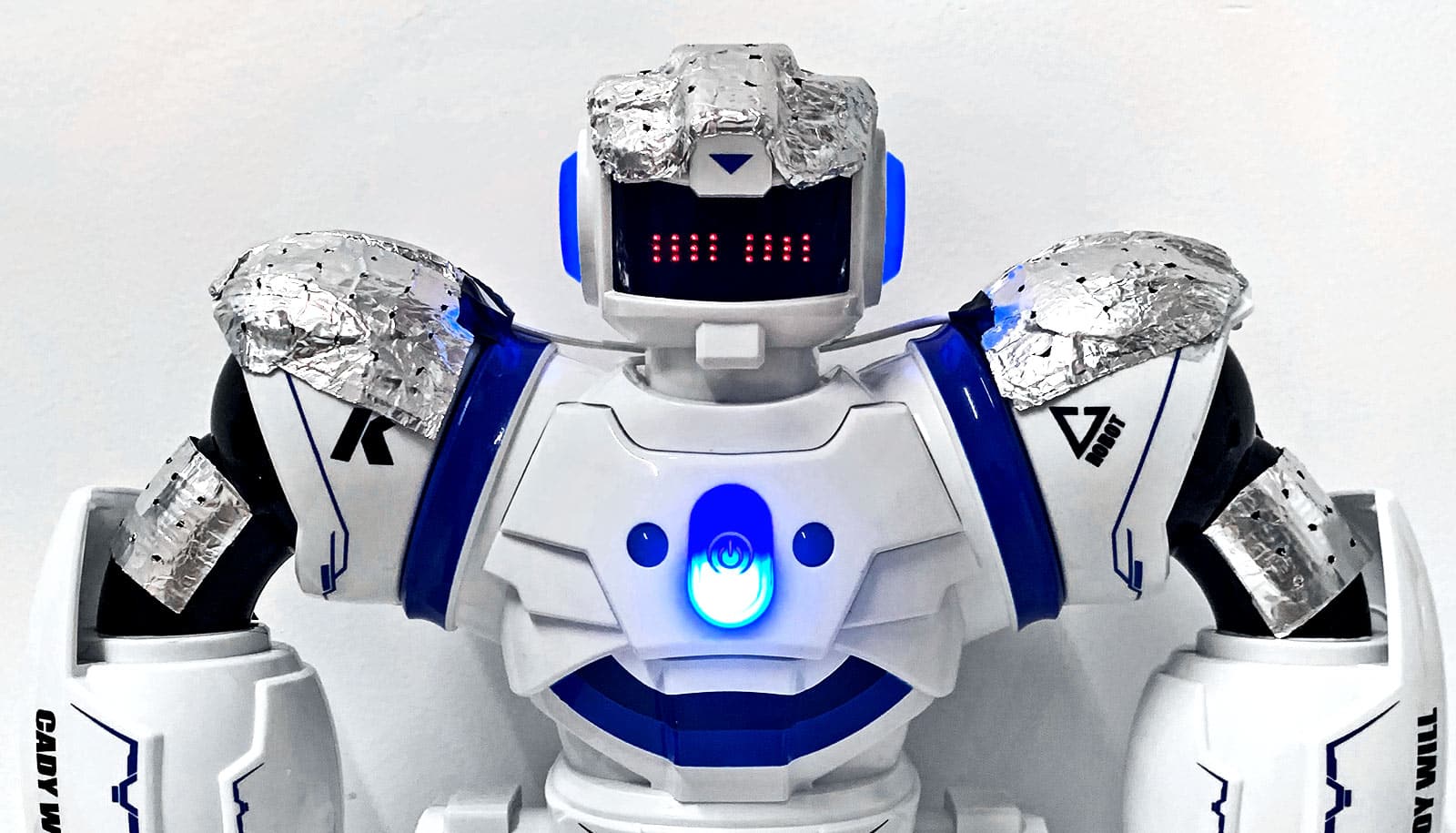
The team replaced a toy robot’s battery with their new biomorphic zinc-air batteries, applied as patches over the robot’s knees, shoulders, elbows, and head. This bio-inspired approach to energy storage, akin to fat reserves in animals, including humans, could free up both space and weight inside robots while simultaneously increasing the energy capacity. (Credit: Mingqiang Wang/Kotov Lab/U. Michigan)
Better robot batteries get inspiration from body fat
Batteries that can conform to the shape of a robot's body double as protection and far more efficient energy storage could pave the way for new bots.
Like biological fat reserves store energy in animals, a new rechargeable zinc battery integrates into the structure of a robot to provide much more energy, researchers report.
“Batteries that can do double duty—to store charge and protect the robot’s ‘organs’—replicate the multifunctionality of fat tissues serving to store energy in living creatures.”
This approach to increasing capacity will be particularly important as robots shrink to the microscale and below—scales at which current stand-alone batteries are too big and inefficient.
“Robot designs are restricted by the need for batteries that often occupy 20% or more of the available space inside a robot, or account for a similar proportion of the robot’s weight,” says Nicholas Kotov, a professor of engineering at the University of Michigan who led the research.
Better batteries for robots
Applications for mobile robots are exploding, from delivery drones and bike-lane take-out bots to robotic nurses and warehouse robots. On the micro side, researchers are exploring swarm robots that can self-assemble into larger devices.
Multifunctional structural batteries can potentially free up space and reduce weight, but until now they could only supplement the main battery.
“Distributed energy storage, which is the biological way, is the way to go for highly efficient biomorphic devices.”
“No other structural battery reported is comparable, in terms of energy density, to today’s state-of-the-art advanced lithium batteries. We improved our prior version of structural zinc batteries on 10 different measures, some of which are 100 times better, to make it happen,” Kotov says.
The combination of energy density and inexpensive materials means that the battery may already double the range of delivery robots, he says.
“This is not the limit, however. We estimate that robots could have 72 times more power capacity if their exteriors were replaced with zinc batteries, compared to having a single lithium ion battery,” says Mingqiang Wang, a recent visiting researcher in Kotov’s lab who is now a postdoctoral researcher at Harbin Institute of Technology in China, and first author of the study in Science Robotics .
How it works
The new battery works by passing hydroxide ions between a zinc electrode and the air side through an electrolyte membrane. That membrane is partly a network of aramid nanofibers—the carbon-based fibers found in Kevlar vests—and a new water-based polymer gel. The gel helps shuttle the hydroxide ions between the electrodes.
Made with cheap, abundant and largely nontoxic materials, the battery is more environmentally friendly than those currently in use. The gel and aramid nanofibers will not catch fire if the battery is damaged, unlike the flammable electrolyte in lithium ion batteries. The aramid nanofibers could be upcycled from retired body armor.
To demonstrate their batteries, the researchers experimented with regular-sized and miniaturized toy robots in the shape of a worm and a scorpion. The team replaced their original batteries with zinc-air cells. They wired the cells into the motors and wrapped them around the outsides of the creepy crawlers.
“Batteries that can do double duty—to store charge and protect the robot’s ‘organs’—replicate the multifunctionality of fat tissues serving to store energy in living creatures,” says Ahmet Emre, a doctoral student in biomedical engineering in Kotov’s lab.
The downside of zinc batteries is that they maintain high capacity for about 100 cycles, rather than the 500 or more that we expect from the lithium ion batteries in our smartphones. This is because the zinc metal forms spikes that eventually pierce the membrane between the electrodes.
The strong aramid nanofiber network between the electrodes is the key to the relatively long cycle life for a zinc battery. And the inexpensive and recyclable materials make the batteries easy to replace.
Beyond the advantages of the battery’s chemistry, Kotov says that the design could enable a shift from a single battery to distributed energy storage, using graph theory approach.
“We don’t have a single sac of fat, which would be bulky and require a lot of costly energy transfer,” Kotov says. “Distributed energy storage, which is the biological way, is the way to go for highly efficient biomorphic devices.”
Funding for the research came from the Department of Defense, the National Science Foundation, and the Air Force Office of Scientific Research. The University of Michigan has applied for patent protection and is seeking commercial partners to bring the technology to market.
Source: University of Michigan
The post Better robot batteries get inspiration from body fat appeared first on Futurity .
Share this article:
This article uses material from the Futurity article, and is licenced under a CC BY-SA 4.0 International License. Images, videos and audio are available under their respective licenses.


